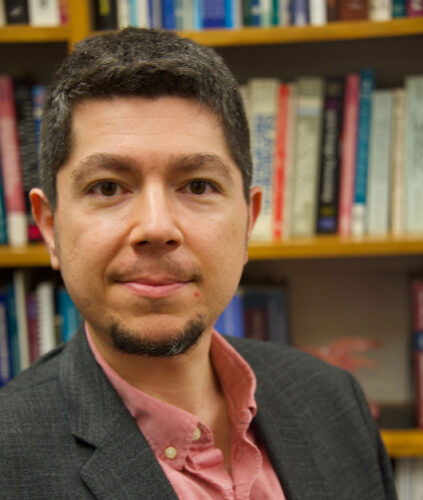Onur Apul
Website: www.onurapul.com
Research Interests
- Physicochemical water treatment
Research Projects
- Integrated Assessment of Alternative Management Strategies for PFAS-contaminated Wastewater Residuals (WRRI 2021)
Resources
- Maine Sustainability & Water Conference, April 1, 2021 – Thermal Regeneration of Spent Granular Activated Carbon Presents an Opportunity to Break the Forever PFAS Cycle.
- Mitchell Center Talk, November 30, 2020 – Sustainable Water Treatment – Moving from Victorian Era Technology to Nanotechnology
Degrees
- Ph.D. in Environmental Engineering and Science, Clemson University, Clemson, SC 2014
- M.S. in Environmental Engineering, Middle East Technical University, Ankara, Turkey 2009
- B.S. in Environmental Engineering, Middle East Technical University, Ankara, Turkey 2006
Courses Taught
- CIE 430 Water Treatment
Profile
Onur is an assistant professor in Civil and Environmental Engineering at the University of Maine. Prior to his appointment, he was an assistant professor in Environmental Engineering at UMass Lowell. He earned his Ph.D. in 2014 in Environmental Engineering at Clemson University, SC. In 2013, his work received the prestigious L.G. Rich Award from the Water Environment Association. In 2015 and 2017, he received the Highly-Cited-Author Recognition by Elsevier’s Water Research Journal. In 2017 and 2018, he received UMass Lowell’s Chancellor Recognition for “highest number of publications and creative works”. In 2019, he received the “Outstanding Teacher Award” from the American Society of Civil Engineers (ASCE) – Student Chapter. Dr. Apul has published more than 40 peer-reviewed journal articles and submitted 5 patent applications to date. He has given 50 presentations including invited keynote lectures and invited talks at national and international meetings. He is a guest editor of Nanomaterials and a member of American Chemical Society, Sustainable Nanotechnology Organization, and the Association of Environmental Engineering and Science Professors.
Dr. Apul’s research focuses on responsibly harvesting nanotechnology to advance safe and sustainable water treatment. He specifically investigates molecular level interactions at the boundary layers to help tackle emerging environmental concerns (such as PFAS in drinking water sources or microplastics in coastal ecosystems).
Selected Publications
Apul, O.G., Perreault, F., Ersan, G., Karanfil, T. (accepted) Linear solvation energy relationship development for adsorption of synthetic organic compounds by carbon nanomaterials: an overview of the last decade
Apul, O.G., Grissom, R., Damali, U., Toof, R. (in-press). Divided Perception of Drinking Water Safety: Another Manifestation of America’s Racial Gap. Environment Science and Technology Water
Apul, O.G., Rowles, S., Khalid, A., Karanfil, T., Richardson, S., Saleh, N. 2020. Transformation potential of cannabinoids during their passage through engineered water treatment systems: A perspective. Environment International, 137, 105586.
Apul, O.G., Hoogesteijn von Reitzenstein, N., Schoepf, J., Ladner, D. Hristovski, K., Westerhoff, P. 2017. Superfine powdered activated carbon incorporated into electrospun polystyrene fibers preserve adsorption capacity. Science of the Total Environment, 592: 458-464.
Apul, O.G., Delgado, A., Kidd, J., Alam, F., Dahlen, P., Westerhoff, P. 2016. Carbonaceous nano-additives augment microwave-enabled thermal remediation of soils containing petroleum hydrocarbons. Environmental Science: Nano, 3: 997-1002.
Apul, O.G., Dahlen, P., Delgado, A., Sharif, F. and Westerhoff, P. 2016. Treatment of heavy, long-chain petroleum-hydrocarbon impacted soils using chemical oxidation Journal of Environmental Engineering-ASCE, 04016065.
Apul, O.G., Zhou, Y. and Karanfil, T. 2015. Mechanisms and modeling of halogenated aliphatic contaminant adsorption by carbon nanotubes. Journal of Hazardous Materials, 295: 138-144.
Apul, O.G. and Karanfil, T. 2015. Adsorption of synthetic organic contaminants by carbon nanotubes: A critical review. Water Research, 68: 34-55.
Apul, O.G., Wang, Q., Shao, T., Rieck J. and Karanfil, T. 2013. Predictive model development for adsorption of aromatic contaminants by multi-walled carbon nanotubes. Environmental Science and Technology, 47(5):2295-2303.
Apul, O.G., Wang, Q., Zhou, Y. and Karanfil, T. 2013. Adsorption of aromatic organic contaminants by graphene nanosheets: Comparison with carbon nanotubes and activated carbon. Water Research, 47(4):1648-1654.
Apul, O.G., Shao, T., Zhang, S. and Karanfil, T. 2012. The impact of carbon nanotube morphology on phenanthrene adsorption. Environmental Toxicology and Chemistry, 31(1):73-78.
Apul, O.G. and Sanin, F.D. 2010. Ultrasonic pretreatment and subsequent anaerobic digestion under different operational conditions. Bioresource Technology, 101(23):8984-8992.
Apul, O.G., Atalar, I., Zorba, G.T. and Sanin, F.D. 2010. The dewaterability of disintegrated sludge samples before and after anaerobic digestion. Drying Technology, 28(7):901-909.
Apul, O.G., Dogan, I. and Sanin, F.D. 2009. Can capillary suction time be an indicator for sludge disintegration? Journal of Residual Science and Technology, 6(3):99-104.

